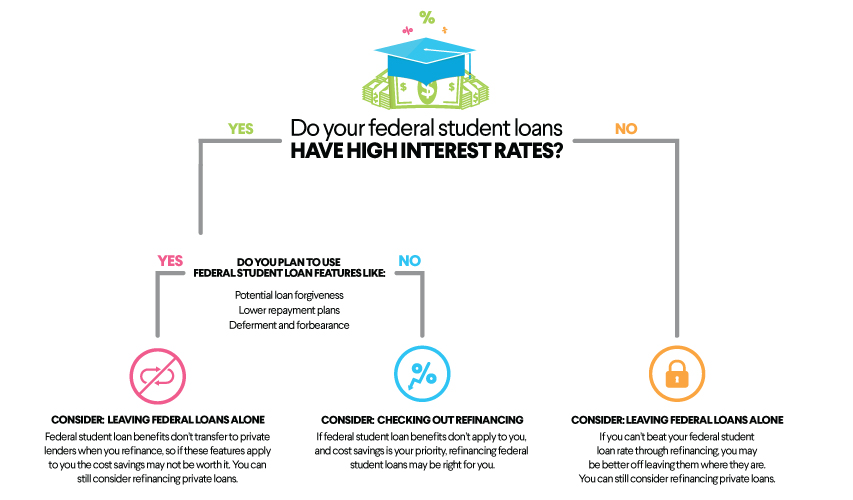Can You Pay Off Student Loans with Your 401(k)?
If you’re one of the 44 million Americans who currently hold a portion of the country’s more than $1.7 trillion student debt—and are perhaps now back to making payments after a three-year pause—chances are you’re looking for solutions to get rid of that debt ASAP. After all, the average student who borrowed money to pay for school graduates with just over $37,000 in federal student loan debt alone.
Paying off that much debt is an impressive feat which takes discipline and commitment. If you’re currently living under the heavy weight of your student loans, you may have considered using your 401(k) for student loans. But should you really cash out your 401(k) for student loans?
It probably goes without saying that figuring out how you’re going to pay off your student loans is overwhelming—and there isn’t one definitive solution. And while it’s certainly tempting to just take the cash from your 401(k) and pay off a high-interest loan, there are some serious drawbacks to consider before running with that plan.
Table of Contents
Key Points
• Using a 401(k) to pay off student loans can eliminate debt quickly but has significant drawbacks, including penalties and lost investment growth.
• Early withdrawal from a 401(k) before age 59½ incurs a 10% penalty and is subject to income tax.
• Alternatives like income-driven repayment plans or loan forgiveness programs offer safer ways to manage student loan debt without risking retirement savings.
• Refinancing student loans might lower interest rates and monthly payments, providing a financial breather without tapping into retirement funds.
• Borrowing from a 401(k) or taking a hardship withdrawal are options, but they compromise future financial stability and retirement planning.
The Downsides of Using Your 401(k) to Pay Off Your Student Loans
A potential benefit of using your 401(k) to pay off student loans is that you can eliminate your debt in one fell swoop. However, withdrawing money from your 401(k) should be considered a last resort option—or maybe not an option at all. That’s because there are several major downsides to doing so:
• Early withdrawal penalty: If you’re under the age of 59½, you’ll generally have to pay a 10% early withdrawal penalty on the amount you take out. The amount you withdraw will also be considered taxable income, which means you could owe a hefty tax bill for that year.
• Opportunity cost: By using your 401(k) money to pay off student loans, you are potentially losing out on an overall higher return from your investments. For example, if your loan has an interest rate of 6% and your 401(k) returns an average of 8% per year, you essentially lose 2% a year by liquidating those funds to pay off your loans.
• Difficulty catching up: With your stunted 401(k) balance, you’ll need to make much larger contributions going forward to make up for it, which could strain your budget. Plus, there is a cap on the total amount you can contribute to a 401(k) each year. You may never be able to fully make up for the growth you would have experienced if that money stayed invested.
When deciding whether or not to withdraw money from your retirement savings, it’s important to note that while you borrow loans for other expenses in life, there’s no such thing as a “retirement loan.” You’re responsible for ensuring you have enough money to live on in retirement.
While it can feel like student loans are preventing you from living your life or meeting your financial goals today, saving for retirement can be a valuable investment in your future.
💡 Quick Tip: Get flexible terms and competitive rates when you refinance your student loan with SoFi.
Alternatives to Help Control Your Student Loan Debt
If you’re struggling with student loan payments, there are alternatives to taking money out of your 401(k) that can help you get your student loan debt under control while keeping your retirement savings intact. Here are a few examples:
Applying for Income-Driven Repayment
March 2025: The SAVE Plan is no longer available after a federal court blocked its implementation in February 2025. Applications for other income-driven repayment plans and for loan consolidation are also on hold. We will update this page as more information becomes available.One option is applying for an income-driven repayment (IDR) plan. These plans reduce your payments to a small percentage of your discretionary income. The term length also gets extended out to 20 or 25 years, depending on the specific program. At the end of the repayment term, any remaining debt is forgiven. The exception is the newest plan, Saving on a Valuable Education (SAVE), which awards forgiveness for some borrowers with smaller balances within as few as 10 years.
Keep in mind that extending your repayment term usually means paying more in interest over the life of the loan. Any canceled IDR debt may also be taxed as income. Still, if your payments are far too high to afford on the Standard Repayment Plan, income-driven repayment could provide much-needed relief. In fact, if your income is below a certain threshold, you could qualify for $0 payments.
Pursuing Loan Forgiveness
There are also many programs that forgive student loans after you’ve worked in a qualifying profession and made a certain number of payments. On the national level, Public Service Loan Forgiveness (PSLF) is one example. If you work for a qualifying employer in the public service sector, such as the government or a non-profit, you can have your loans forgiven after 120 payments. Other similar programs include Teacher Loan Forgiveness and National Defense Student Loan Discharge.
In addition to federal forgiveness programs, there are also hundreds of programs offered through states, schools, and other organizations.
Refinancing Your Student Loans
When you refinance your student loans, you take out a brand new loan from a private lender, who will review your credit history and other financial factors to determine how much they will lend to you and at what rate. You then use those funds to pay off your existing loan(s).
With a solid financial picture and credit history, you could qualify for a lower interest rate. This could result in lower monthly payments, as well as reducing the amount of money you spend in interest over the life of the loan (depending on the loan term, of course).
You could also lower your monthly payments by extending the length of the loan term. This results in paying more money in interest over the life of the loan, but could help free up some cash flow more immediately.
It’s important to note that refinancing federal student loans with a private lender means you’ll permanently lose access to federal loan benefits including income-driven repayment plans, forbearance, and deferment.
To help you decide if refinancing is a good idea, take a look at SoFi’s student loan payoff calculator to see when you might pay off your current loans. Then compare that with a potential new loan—you may be surprised at how much of a difference refinancing can make. And with more wiggle room in your budget, you could make headway toward student loan repayment and save for a retirement you’ll be able to enjoy.
Take control of your student loans.
Ditch student loan debt for good.
💡 Quick Tip: When refinancing a student loan, you may shorten or extend the loan term. Shortening your loan term may result in higher monthly payments but significantly less total interest paid. A longer loan term typically results in lower monthly payments but more total interest paid.
Options for Using Your 401(k) to Pay Off Debt
If you decide to pursue using 401(k) funds to pay off student loans despite the many risks and drawbacks, there are a few ways to go about it. First, you’ll need to determine how much you are eligible to withdraw from your 401(k), and what penalties and taxes you would encounter. In most cases, you would be responsible for a 10% penalty and regular income taxes on a withdrawal from your 401(k) prior to age 59 ½.
There are a few exceptions to this rule. For instance, if you were laid off, you may be able to withdraw money penalty-free as long as certain requirements are met.
And depending on the exact terms of your 401(k) plan, you may be able to withdraw the money from your plan without penalty in certain hardship situations—like to cover tuition or medical expenses.
If you already attended college and are trying to use your 401(k) to pay back student loans, that doesn’t qualify for a hardship withdrawal. If you’re not sure what the exact rules of your plan entail, it’s worth contacting your HR representative or the financial firm that handles your company’s 401(k) program.
Again, using money from your 401(k) to pay off debt can be a risky proposition. While on the bright side it would potentially allow you to eliminate your student debt, it also puts your retirement savings at risk. You’ll not only potentially have to pay a penalty and taxes on the withdrawn amount, but you’ll also lose out on years of compounding returns on money you take out.
Still, depending on your circumstances, you might be considering cashing out your entire 401(k). Alternatively, however, you could borrow against your 401(k) by taking out a 401(k) loan. Here’s a bit more info about those two options.
Cashing Out Your 401(k)
Withdrawing money from your 401(k) can seem like a tempting idea when your student loan payments are causing you to stress at the moment and retirement feels like it’s ages away.
But making an early withdrawal comes with penalties. If you withdraw your money prior to the age of 59 ½ you’ll pay a 10% penalty on the amount you withdraw, in addition to regular income tax on the distribution itself. In addition to the taxes and the early withdrawal penalty, money that you withdraw loses valuable time to grow between now and retirement. That is why, as mentioned, simply withdrawing money from a 401(k) very rarely makes sense, when you consider the taxes, penalties, and lost growth.
To reinforce this point, let’s consider a (completely hypothetical) person who earns $68,000 per year and is a single filer, putting them in the 22% income tax bracket. (And remember, this is just an example – there are many other factors that can come into play, but this should give you a high-level glimpse into why withdrawing cash from your 401(k) might not be the best call.)
If this person cashed out $20,000 from their 401(k), they would have to pay a 10% penalty of $2,000 right off the top. Then they’d need to pay federal income taxes at the highest end of their bracket, totaling $4,400. So even though this person took out $20,000 from their account, they actually receive just $13,600. Depending on their state, they might also pay state income taxes, let’s not get bogged down on that right now.
Now let’s assume they used that money to pay off $13,600 in student loans, which have a 5% interest rate and five years left on the loan. In this scenario, they would save roughly $1,798.93 in interest.
So essentially, this person would have incurred $6,400 in penalties and taxes in order to save $1,798.93 in interest. Plus, had they let that money stay invested in their 401(k) over the next five years, that $20,000 could have grown to more than $28,000, assuming a 7% average return. That’s why cashing out a 401(k) to pay off student loan debt might not be a great idea.
Borrowing from Your 401(k)
When you borrow money from your own 401(k), you are really borrowing from yourself. You are accessing your retirement funds and then paying them back, with interest, in an attempt to replenish your savings. So these loans don’t require a formal application or credit check.
Not all companies offer 401(k) loans, so it’s important to check with your employer to confirm if the option is available to you. (And for the record, you can’t take out a loan from an employer-sponsored 401(k) if you’re no longer with that employer.)
In addition to the rules determined by your employer, the IRS sets limits on 401(k) loans as well. The current maximum loan amount as determined by the IRS is 50% of your vested balance
or $50,000, whichever is less. If you have a balance of less than $10,000, you may be able to borrow up to $10,000.
The IRS also requires that the money borrowed from your 401(k) be paid back within five years based on a payment plan that is established when you borrow the money. There is an exception; if you buy a house with the money you withdraw, you may be able to extend the repayment plan.
If you don’t pay the loan back according to the terms, it’s considered defaulted and the balance may be treated as a distribution instead. That means you’d owe penalties and taxes on that amount for that year.
Note that if you change jobs, your 401(k) plan will roll over, but not your loan. If you leave your employer with an unpaid 401(k) balance, you’ll face an accelerated payment plan.
Interest rates are usually set by your plan administrator, and are relatively low compared to other financing options. It could be a viable option for those interested in securing a lower interest rate for their debt, but don’t qualify for student loan refinancing due to their credit history or other factors.
A 401(k) loan typically offers a relatively low interest rate and doesn’t require a credit check.
You may want to crunch some numbers and compare the interest rates on your student loans with the interest rate on a 401(k) loan before you commit to this course of action.
If your student loan interest rate is lower than the potential interest rate on your 401(k) loan, it could make sense to keep your retirement savings intact.
The other factor to consider is the missed growth on the money you borrow from your 401(k), which is why 401(k) loans could make more sense for high-interest debt such as personal loans or credit cards, but are typically less ideal for low-interest debt such as student loans or mortgages.
Hardship Withdrawals
While a hardship withdrawal won’t be an option if you are looking to pay off your student loans, it could be worth considering if you are planning on attending graduate school or are assisting a family member with their college education.
To qualify for a hardship withdrawal, you must meet certain criteria. You must prove your need is immediate and heavy. Tuition for the school year usually qualifies as immediate.
Student loan repayment wouldn’t qualify because they provide a repayment plan over a set period of time. You must also prove the expense is heavy. Usually, that means things like college tuition, a down payment on a primary residence, or a qualifying medical expense that is 10% or more of your adjusted gross income.
Looking to lower your monthly student loan payment? Refinancing may be one way to do it — by extending your loan term, getting a lower interest rate than what you currently have, or both. (Please note that refinancing federal loans makes them ineligible for federal forgiveness and protections. Also, lengthening your loan term may mean paying more in interest over the life of the loan.) SoFi student loan refinancing offers flexible terms that fit your budget.
SoFi Student Loan Refinance
Terms and conditions apply. SoFi Refinance Student Loans are private loans. When you refinance federal loans with a SoFi loan, YOU FOREFEIT YOUR EILIGIBILITY FOR ALL FEDERAL LOAN BENEFITS, including all flexible federal repayment and forgiveness options that are or may become available to federal student loan borrowers including, but not limited to: Public Service Loan Forgiveness (PSLF), Income-Based Repayment, Income-Contingent Repayment, extended repayment plans, PAYE or SAVE. Lowest rates reserved for the most creditworthy borrowers. Learn more at SoFi.com/eligibility. SoFi Refinance Student Loans are originated by SoFi Bank, N.A. Member FDIC. NMLS #696891 (www.nmlsconsumeraccess.org).
SoFi Loan Products
SoFi loans are originated by SoFi Bank, N.A., NMLS #696891 (Member FDIC). For additional product-specific legal and licensing information, see SoFi.com/legal. Equal Housing Lender.
Financial Tips & Strategies: The tips provided on this website are of a general nature and do not take into account your specific objectives, financial situation, and needs. You should always consider their appropriateness given your own circumstances.
Tax Information: This article provides general background information only and is not intended to serve as legal or tax advice or as a substitute for legal counsel. You should consult your own attorney and/or tax advisor if you have a question requiring legal or tax advice.
SOSL0923041
Read more




